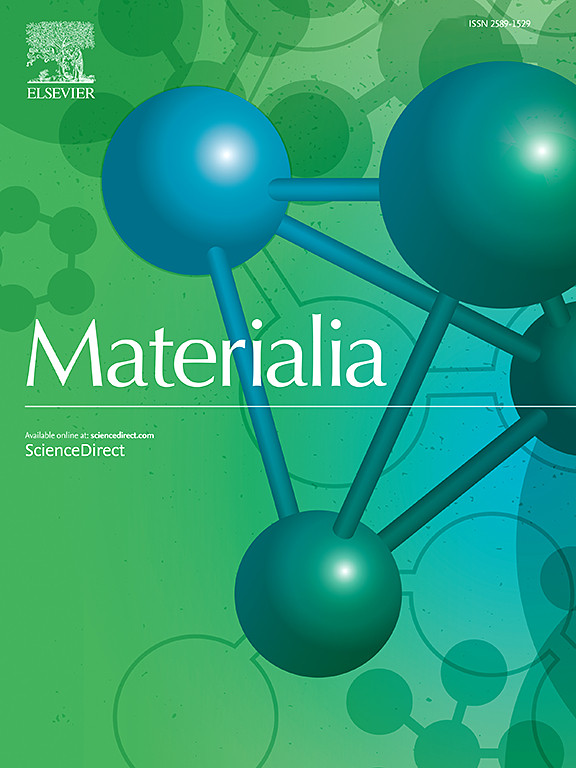钢-铝接头界面金属间层的演化:热力学和粘附的观点
IF 3
Q2 MATERIALS SCIENCE, MULTIDISCIPLINARY
引用次数: 0
摘要
由于熔点的差异和铁在铝中的溶解度有限,镀锌钢与铝的异种焊接一直面临着巨大的挑战。传统的熔焊通常会在界面处形成厚而脆的金属间化合物(IMCs),从而影响接头的完整性。焊接通过使用更低的热量输入减少了这些问题,从而减少了IMC厚度并最大限度地降低了锌涂层蒸发的风险。然而,尽管对钢-铝焊接钎焊接头进行了研究,但界面IMC层的确切作用以及合金元素对IMC层的热力学形成和粘附性能的影响仍未得到充分探讨,这导致了钢-铝异种钎焊的持续挑战。本研究研究了钢-铝界面界面层的热力学形成,重点研究了其粘附性能、形貌和组成。分析强调了这些界面特征如何影响两种镀锌钢体系:镀锌(GI)和ZnAlMg (ZAM)涂层中接头的破坏行为。研究发现水平和垂直界面的IMC层的组成和形态存在差异,垂直界面被认为是剪切-拉伸载荷作用下的临界破坏区域。结果表明,与ZnAlMg涂层相比,gi涂层接头的峰值载荷更高,这是由于界面层的形貌、厚度和组成的差异。该研究强调了锌涂层成分对焊接钎焊接头机械性能的关键影响,并为提高汽车行业钢铝接头的可靠性提供了见解。本文章由计算机程序翻译,如有差异,请以英文原文为准。

Evolution of interfacial intermetallic layers in steel-aluminum joints: Thermodynamic and adhesion perspectives
The dissimilar welding of zinc-coated steel to aluminum has long posed significant challenges due to differences in melting points, and the limited solubility of iron in aluminum. Traditional fusion welding often results in the formation of thick, brittle intermetallic compounds (IMCs) at the interface, compromising joint integrity. Weld-brazing reduces these issues by utilizing lower heat inputs, thereby reducing IMC thickness and minimizing the risk of zinc coating evaporation. However, despite studies on the weld-brazed steel-to-aluminum joints, the exact role of interfacial IMC layers, along with the influence of alloying elements on the thermodynamic formation and adhesion properties of IMC layers, remains underexplored, contributing to the ongoing challenges in dissimilar weld-brazing of steel to aluminum. This study investigates the thermodynamic formation of interfacial layers at steel-aluminum interfaces, emphasizing their adhesion properties, morphology, and composition. The analysis highlights how these interfacial characteristics influence the failure behavior of joints in two zinc-coated steel systems: galvanized (GI) and ZnAlMg (ZAM) coatings. The study identified differences in the composition and morphology of IMC layers at horizontal and vertical interfaces, with the vertical interface considered as a critical failure region under shear-tensile loading. The results showed a higher peak load in GI-coated joints compared to those with ZnAlMg coating, which was attributed to differences in the morphology, thickness, and composition of the interfacial layers. This study underscores the critical influence of zinc coating composition on the mechanical performance of weld-brazed joints and provides insights that could improve the reliability of steel-aluminum joints in the automotive industry.
求助全文
通过发布文献求助,成功后即可免费获取论文全文。
去求助
来源期刊

Materialia
MATERIALS SCIENCE, MULTIDISCIPLINARY-
CiteScore
6.40
自引率
2.90%
发文量
345
审稿时长
36 days
期刊介绍:
Materialia is a multidisciplinary journal of materials science and engineering that publishes original peer-reviewed research articles. Articles in Materialia advance the understanding of the relationship between processing, structure, property, and function of materials.
Materialia publishes full-length research articles, review articles, and letters (short communications). In addition to receiving direct submissions, Materialia also accepts transfers from Acta Materialia, Inc. partner journals. Materialia offers authors the choice to publish on an open access model (with author fee), or on a subscription model (with no author fee).
 求助内容:
求助内容: 应助结果提醒方式:
应助结果提醒方式:


